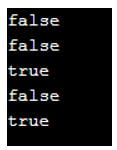Updated April 4, 2023
Introduction to Perl boolean
Perl boolean type is a type of value that, unlike other programming languages, behaves differently in a manner where the function using these values returns true or false. Perl programming language is not considered conventional when it comes for making the value as true or false. These values are used only for interpretation and significance that these are boolean values, not the actual values for manipulation. A boolean value is not majorly used in Perl language; rather, it is used only when the typical systems have made use of these as return types for identification and manipulation.
Syntax:
There is no proper syntax, but still, Perl boolean value is used many times wherever the need is to have a native boolean data type instead of scalar values, and its representation is as follows:
use boolean;
do &always if true_val;
do &never if false_val;
do &maybe if boolean($val)->is_True;The module as boolean makes use of basic as data type which is used for making the entire system comprising f values which is true or false depending on the value.
How boolean Type Works in Perl?
There are many ways to represent the boolean values in Perl for which the programmer depends or work for with the help of making the process of evaluating the conditional checking, system checking and many other factors which depends on the boolean type of Perl. These values are not any kind of special values that need to have value as true or false. On the other hand, there are a number of ways in which the value is being taken care of in terms of boolean.
- There are some values that are always false in the Perl programming language, namely, ‘undef’, 0, 0.0, ‘’, ‘0’.
- Boolean for Perl programming language uses other scalar values but not the naïve values like other programming languages.
- Boolean in Perl can be of many types, like if in case the value comes out to be truth, then it needs conversion into the value as false depending on the type of requirement at the time of implementation.
- Most often, the values come out to be false, but within that value of return, there might be some inbuild system variables which internally gets a comparison with the values and returns the value as true within it, which is mentioned in an example further.
- There are times when boolean is used for undef and empty string; then, in that case, it is very much needed to make the entire set of boolean justifiable with the other values that need conversion and worthy for representation.
- Using Strict and warnings for the values and the programs in execution is quite useful whenever needed to get the troubleshooting done correctly.
- Strict and warning usage with the empty string in consideration sometimes provides the warning for any Perl program into execution. Also, it helps in making the overall result to be moved in some streamlined way.
- There are some values as 0, which is true in some or the other way where the boolean values are text in the form of string and then when it is used, it gets converted into some type of number converted into some value with string.
- There are some of the values which are considered as truth with respect to the usage of the unary operator and can be converted into a lie when used with a single operator; other than that, when double unary operator !! is used, it will be used for converting the entire value as a lie.
Examples of Perl boolean
Given below are the examples of Perl boolean:
Example #1
This program demonstrates the use of Perl statement, which is used as a conditional statement to check whether the value taken is true or false depending on the scenario and requirement.
Code:
#!/usr/bin/perl
if ('even_no') {
print 'true';
} else {
print 'false';
}Output:
Example #2
This program demonstrates the false values for the variable being assigned a value as 0, as shown in the output.
Code:
#!/usr/bin/perl
$at_1 = 0;
if ($at_1)
{
print "at_1 is True\n";
}
else
{
print "at_1 is False\n";
}Output:
Example #3
This program demonstrates the use of undef with the condition in Perl, which is used for giving the output as shown.
Code:
#!/usr/bin/perl
foreach my $vl_3 (undef, 0, 0.5, '', '8') {
if ($vl_3) {
print "true\n";
} else {
print "false\n";
}
}Output:
Example #4
This program demonstrates the empty string, which is used for checking the condition with the value to be returned as true or false as shown in the output.
Code:
#!/usr/bin/perl
$bt_emp = '';
if ($bt_emp)
{
print "bt_emp is True\n";
}
else
{
print "bt_emp is False\n";
}Output:
Example #5
This program is used for demonstrating the values by using warnings or strict as a standard file inclusion for a variable as shown in the output.
Code:
#!/usr/bin/perl
use warnings;
use strict;
my $one_vr = undef;
print $one_vr + 2;Output:
Example #6
There are times when the value as string internally gets converted into the value as 0 and then when compared with the conditional check by evaluation is considered as shown in the output where the string is fed as an input to the value, and then it throws the value as true as shown.
Code:
#!/usr/bin/perl
if ('0FR1RG') {
print 'true';
} else {
print 'false';
}Output:
Example #7
This program demonstrates the use of unary operator ! which is used for making the value as truth from lie with the canonical format that is often used for manipulation.
Code:
#!/usr/bin/perl
use Data::Dumper;
print Dumper !!'Welcome_Everyone!';Output:
Conclusion
Perl boolean is a type of boolean value used for making the Perl language use and identifies the return type by other methods and functions as true or false. Overall, Perl boolean, although not used so much significantly but once used, can solve many problems related to conditional check and evaluation, which programmers most often use.
Recommended Articles
This is a guide to Perl boolean. Here we discuss the introduction, how boolean type works in Perl? Along with examples, respectively. You may also have a look at the following articles to learn more –








